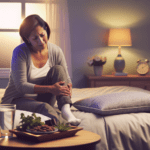Menopause and Postmenopausal Symptoms
Menopause marks a significant transition in a woman’s life, typically occurring in the early 50s, but it can range from the 30s to the mid-50s or later. It is defined as the cessation of menstrual periods for one continuous year, signaling the end of fertility. This natural biological process is characterized by hormonal changes, particularly a decline in estrogen and progesterone levels, leading to various symptoms such as hot flashes, night sweats, vaginal dryness, and mood changes. Postmenopausal symptoms can persist beyond the cessation of menstruation, affecting a woman’s quality of life.
Differentiating Menopause Cramps from Menstrual Cramps
While menstrual cramps are a familiar discomfort for many women, associated with the contraction of uterine muscles during the menstrual cycle, menopause cramps are less understood. These cramps can occur even without menstruation and are often linked to hormonal fluctuations during the menopausal transition. Unlike the predictable nature of menstrual cramps, menopause cramps can be sporadic and are sometimes indicative of other underlying health issues that may arise during this stage of life.
Overview of Causes and Concerns for Postmenopausal Cramps
Postmenopausal cramps can be attributed to various causes, ranging from benign hormonal changes to more serious gynecological conditions. Hormonal imbalances can lead to gastrointestinal issues, exacerbate pre-existing conditions like fibroids or endometriosis, and even contribute to the development of ovarian or uterine cancers. It is crucial for postmenopausal women to monitor their symptoms and seek medical evaluation for persistent or severe cramps, as they may signal conditions that require prompt attention and treatment.
In summary, menopause cramps are a symptom that can arise from the complex hormonal changes occurring during menopause. Differentiating them from menstrual cramps is essential for understanding and managing this postmenopausal concern. Awareness of the potential causes and associated health risks is vital for women navigating this stage of life, ensuring they can maintain their well-being and address any issues that may arise.
Common Causes of Cramps After Menopause
Hormonal Changes and Their Impact on the Body
As women enter menopause, the body undergoes significant hormonal changes, particularly a decrease in estrogen and progesterone levels. These hormonal fluctuations can lead to a variety of symptoms, including hot flashes, night sweats, and vaginal dryness. Additionally, they can affect the musculoskeletal system, potentially causing cramps and discomfort. The lack of estrogen may also influence the gastrointestinal tract, leading to cramps that mimic menstrual pain.
Gynecological Conditions: Fibroids and Endometriosis
Uterine Fibroids: Although fibroids are more common before menopause, they can still be present in postmenopausal women. These benign growths can cause symptoms such as pelvic pressure or cramps, even after periods have ceased.
Endometriosis: This condition involves the growth of uterine lining tissue outside the uterus. While it typically affects women of reproductive age, postmenopausal women can also experience symptoms, especially if they are on hormone therapy for menopausal symptoms. Endometriosis can cause pelvic pain, cramping, and discomfort.
Gastrointestinal Issues Linked to Hormonal Fluctuations
Estrogen has an influence on the gastrointestinal (GI) tract, and its decline during menopause can lead to GI disturbances. Conditions such as irritable bowel syndrome (IBS) may worsen after menopause, causing abdominal pain and cramping. Additionally, gastrointestinal issues like constipation or gastroenteritis can lead to cramping and discomfort in the lower abdomen.
The Role of Ovarian and Uterine Cancers
Ovarian and uterine cancers are more prevalent in postmenopausal women and can manifest as abdominal or pelvic cramping. These cancers often present with other symptoms such as vaginal bleeding, bloating, and fatigue. It is crucial for women experiencing these symptoms to seek medical evaluation, as early detection is key to effective treatment.
Ovarian Cysts: Rarity and Risks in Postmenopause
Ovarian cysts are less common after menopause because ovulation ceases. However, if cysts do develop, they may require closer monitoring as there is a potential, albeit rare, risk of malignancy. Postmenopausal women with ovarian cysts may experience pelvic cramps, and medical evaluation is recommended to rule out the possibility of cancer.
Risk Factors for Postmenopausal Cramps
Genetic Predispositions and Family History
One of the significant risk factors for experiencing cramps after menopause is genetic predisposition. If there is a history of gynecological conditions such as fibroids or endometriosis in the family, the likelihood of experiencing similar issues postmenopause may increase. Additionally, a family history of ovarian or uterine cancers can elevate the risk of postmenopausal cramps, as these conditions can manifest with similar symptoms. It is essential for individuals with such family histories to remain vigilant and undergo regular check-ups to monitor their gynecological health.
Lifestyle and Health Factors
Lifestyle choices and overall health also play a crucial role in the development of postmenopausal cramps. Factors such as obesity, high blood pressure, and a sedentary lifestyle can contribute to the risk. Poor dietary habits, stress, and certain medications may exacerbate gastrointestinal issues, which can lead to cramping. Moreover, habits like smoking can affect hormone levels and potentially lead to cramps. It is advisable for postmenopausal individuals to maintain a healthy lifestyle, including regular exercise and a balanced diet, to minimize these risks.
Age-Related Risks and Hormone Therapy
As women age, the risk of developing conditions that can cause postmenopausal cramps increases. The onset of menopause itself is a significant transition, with the average age in the United States being 51 years. Women who experience menopause later than average may have prolonged exposure to estrogen, which can influence the development of conditions like fibroids and endometriosis, potentially leading to postmenopausal cramps. Additionally, hormone therapy, often prescribed to manage menopausal symptoms, can sometimes exacerbate conditions like endometriosis, leading to cramps even after the menstrual cycle has ceased. It is crucial for those undergoing hormone therapy to be closely monitored by their healthcare providers to manage any adverse effects and address symptoms such as cramps effectively.
In conclusion, understanding the risk factors for postmenopausal cramps is vital for early detection and management. Genetic predispositions, lifestyle choices, and age-related changes all contribute to the likelihood of experiencing these symptoms. By recognizing these risks and engaging in preventative health measures, individuals can better navigate the postmenopausal phase with fewer complications.
Diagnosis of Postmenopausal Cramps
Medical History and Symptom Assessment
The initial step in diagnosing postmenopausal cramps involves a thorough review of the patient’s medical history and a detailed symptom assessment. Healthcare providers will inquire about the duration, intensity, and nature of the cramps, as well as any accompanying symptoms such as vaginal bleeding, abdominal swelling, or changes in bowel habits. It is crucial to differentiate these cramps from other types of abdominal pain to guide further diagnostic procedures. A detailed history helps to identify any risk factors, such as a family history of gynecological cancers or the use of hormone therapy, which may influence the likelihood of certain conditions.
Imaging Techniques and Their Uses
Imaging techniques play a vital role in the diagnosis of postmenopausal cramps. These non-invasive methods provide visual insights into the pelvic organs and can help identify abnormalities such as fibroids, ovarian cysts, or signs of cancers. Common imaging modalities include:
- Transvaginal ultrasound: This procedure involves inserting a probe into the vagina to obtain detailed images of the uterus, ovaries, and other pelvic structures.
- MRI (Magnetic Resonance Imaging): MRI scans offer high-resolution images and are particularly useful in differentiating between benign and malignant growths.
- CT (Computed Tomography) scan: A CT scan provides cross-sectional images of the body and can detect abnormalities in the pelvic region.
- Hysterosonography: This specialized ultrasound is performed by filling the uterine cavity with saline to better visualize the endometrial lining and identify polyps or fibroids.
These imaging tests can help narrow down the potential causes of cramps and guide further diagnostic or therapeutic interventions.
Biopsy Procedures for Further Analysis
If imaging tests suggest the presence of abnormal tissue, a biopsy may be necessary to determine the nature of the condition. During a biopsy, a small sample of tissue is collected for microscopic examination. Types of biopsies include:
- Endometrial biopsy: A sample of the lining of the uterus (endometrium) is taken to check for hyperplasia, polyps, or cancerous cells.
- Hysteroscopy: A thin, lighted instrument called a hysteroscope is inserted through the vagina and cervix into the uterus, allowing the doctor to view the inside of the uterus and perform a directed biopsy.
- Dilation and curettage (D&C): This procedure involves dilating the cervix and scraping the uterine lining to collect tissue. It is often done in conjunction with a hysteroscopy.
Biopsy results can provide definitive evidence of benign or malignant conditions, which is essential for determining the appropriate course of treatment. It is important to note that while the prospect of a biopsy can be concerning, many conditions that cause postmenopausal cramps are benign and effectively treatable.
Treatment Options for Menopause Cramps
Medications for Hormonal and Gastrointestinal Management
For many women experiencing menopause cramps, the first line of treatment often involves medication. Hormonal medications can be used to treat conditions such as fibroids or endometriosis, which may persist or even develop after menopause. These medications help to regulate the hormonal imbalances that contribute to the growth of fibroids and the painful symptoms of endometriosis. Additionally, gastrointestinal issues linked to hormonal fluctuations can also be managed with specific medications designed to alleviate cramping and discomfort.
Surgical Interventions: Hysterectomy and Other Procedures
In cases where medication is not effective or when the underlying cause of cramps is severe, surgical interventions may be necessary. A hysterectomy, the surgical removal of the uterus, may be recommended for persistent fibroids, endometriosis, or uterine cancers that cause postmenopausal cramps. Other less invasive procedures may also be considered, depending on the individual’s condition and the recommendation of their healthcare provider.
Hormone Therapy and Its Effectiveness
Hormone therapy, involving estrogen and progesterone, can be an effective treatment for managing menopause symptoms, including cramps. Hormone therapy helps to replenish the hormones that are at lower levels during menopause, thereby reducing cramping and other associated symptoms. However, the effectiveness of hormone therapy can vary from person to person, and it is important to discuss the potential risks and benefits with a healthcare provider.
Cancer Treatments: Surgery, Radiation, and Chemotherapy
When postmenopausal cramps are a symptom of ovarian or uterine cancers, treatment options may include surgery, radiation, and chemotherapy. Surgery can involve the removal of the tumor or, in some cases, the affected organ. Radiation therapy and chemotherapy are used to target and kill cancer cells, and may be used in conjunction with surgery. The specific treatment plan will depend on the type and stage of cancer, as well as the overall health of the individual.
It is crucial for women experiencing menopause cramps to consult with their healthcare provider to determine the underlying cause and appropriate treatment. Early diagnosis and treatment can significantly improve the quality of life and reduce the risk of complications associated with postmenopausal cramps.

From unhappy, dry, and sandpaper to silky, smooth and feeling good. That’s Cleo. Cleo is a 100% natural labial balm to moisture and soothe “your other lips”. Cleo is chemical-free, water-free, pH optimized and helps maintain and restore your delicate labial skin’s natural flora. Ideal for daily use or as needed. Get the most silky, lovable lips ever.
Home Remedies and Lifestyle Changes
Pain Relief Through Over-the-Counter Medications
For many women experiencing menopause cramps, over-the-counter (OTC) pain relievers can offer significant relief. Nonsteroidal anti-inflammatory drugs (NSAIDs) such as ibuprofen and naproxen can help reduce inflammation and alleviate pain. Acetaminophen is another option for those who may not tolerate NSAIDs well. It’s important to follow the dosage instructions on the packaging and consult with a healthcare provider if the recommended dose does not provide relief or if there are any concerns about interactions with other medications.
Heat Therapy and Pelvic Massage Techniques
Applying heat to the lower abdomen can help relax the muscles and ease cramping. This can be done with a hot water bottle, a heating pad, or by taking a warm bath. The warmth not only soothes the pain but also improves blood flow, which can help reduce discomfort. Additionally, gentle pelvic massage can help to further relax tense muscles and provide relief from cramps. Using circular motions, massage the lower abdomen to help alleviate tension.
Dietary Adjustments and Stress Reduction
Making dietary changes can also play a role in managing menopause cramps. Foods rich in omega-3 fatty acids, such as fish and flaxseeds, can have anti-inflammatory effects. Increasing the intake of fruits, vegetables, and whole grains can improve overall health and potentially reduce cramping. It’s also beneficial to stay hydrated and limit intake of caffeine and alcohol, which can exacerbate symptoms. Stress reduction techniques such as yoga, meditation, and deep breathing exercises can also help manage cramps by promoting relaxation and reducing tension in the body.
Importance of Rest and Physical Activity
Getting adequate rest is crucial for overall well-being and can help the body manage pain more effectively. Ensure a comfortable sleeping environment and try to maintain a consistent sleep schedule. On the other hand, regular physical activity is equally important. Activities like walking, swimming, or gentle yoga can increase endorphin levels, the body’s natural painkillers, and improve mood. Exercise can also help with weight management, which is important as excess weight can increase the severity of menopause symptoms.
While these home remedies can be effective for easing menopause cramps, it’s essential to listen to your body and consult a healthcare provider if symptoms persist or worsen. They can provide guidance on additional treatment options and ensure that the cramps are not a sign of a more serious underlying condition.

Popular Read
When to Consult a Healthcare Provider
Identifying Alarming Symptoms and Patterns
While some postmenopausal cramps may not signal a serious issue, certain symptoms should prompt immediate medical attention. It’s crucial to be vigilant about changes in your body and to recognize patterns that may indicate underlying health concerns. Alarming symptoms include:
- Severe or persistent abdominal pain
- Cramps accompanied by vaginal bleeding
- Unexplained weight loss or gain
- Abdominal bloating or swelling
- Pain during sex, urination, or bowel movements
- Extreme fatigue or leg swelling
Any of these symptoms, especially if they persist or worsen, warrant a consultation with a healthcare provider.
The Significance of Timely Medical Evaluation
Delaying a medical evaluation for postmenopausal cramps can lead to complications if an underlying condition is present. Early detection and treatment of conditions such as endometriosis, fibroids, or even cancers can significantly improve outcomes. A timely medical evaluation may include a thorough physical examination, imaging tests like ultrasounds or MRIs, and possibly a biopsy to rule out or confirm a diagnosis.
Summary of Menopause Cramps and Treatment Necessity
Menopause cramps can stem from various causes, ranging from benign gastrointestinal issues to more serious gynecological conditions. While some cramps may be managed with lifestyle changes and home remedies, others may require medical interventions such as hormone therapy, medications, or surgery. Understanding when to seek treatment is essential for maintaining your health and well-being during postmenopause.
Frequently Asked Questions
- Why am I experiencing cramps after menopause?
- Postmenopausal cramps can be due to hormonal changes, gynecological conditions like fibroids or endometriosis, gastrointestinal issues, or even ovarian and uterine cancers.
- How can I alleviate menopause cramps at home?
- Over-the-counter pain medications, heat therapy, pelvic massages, dietary adjustments, and stress reduction techniques can help manage cramps. However, it’s important to consult a healthcare provider if cramps persist.
- When should I see a healthcare provider for menopause cramps?
- Consult a healthcare provider if you experience cramps that are severe, do not go away, worsen over time, or are accompanied by other concerning symptoms such as vaginal bleeding.










